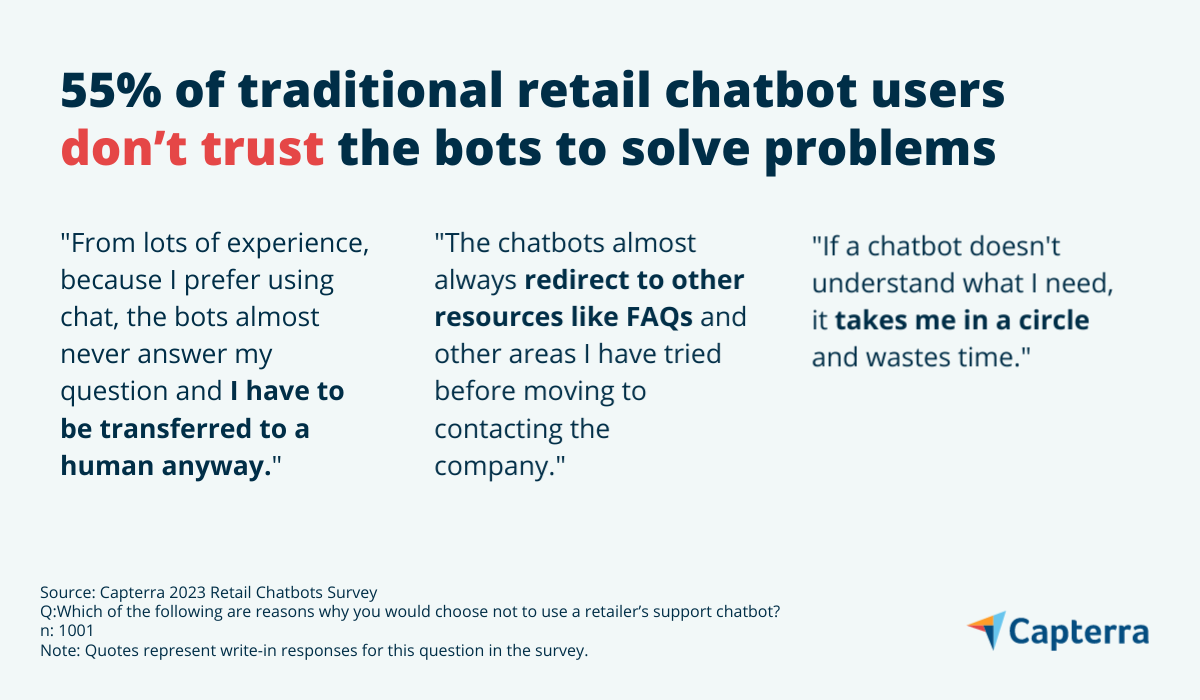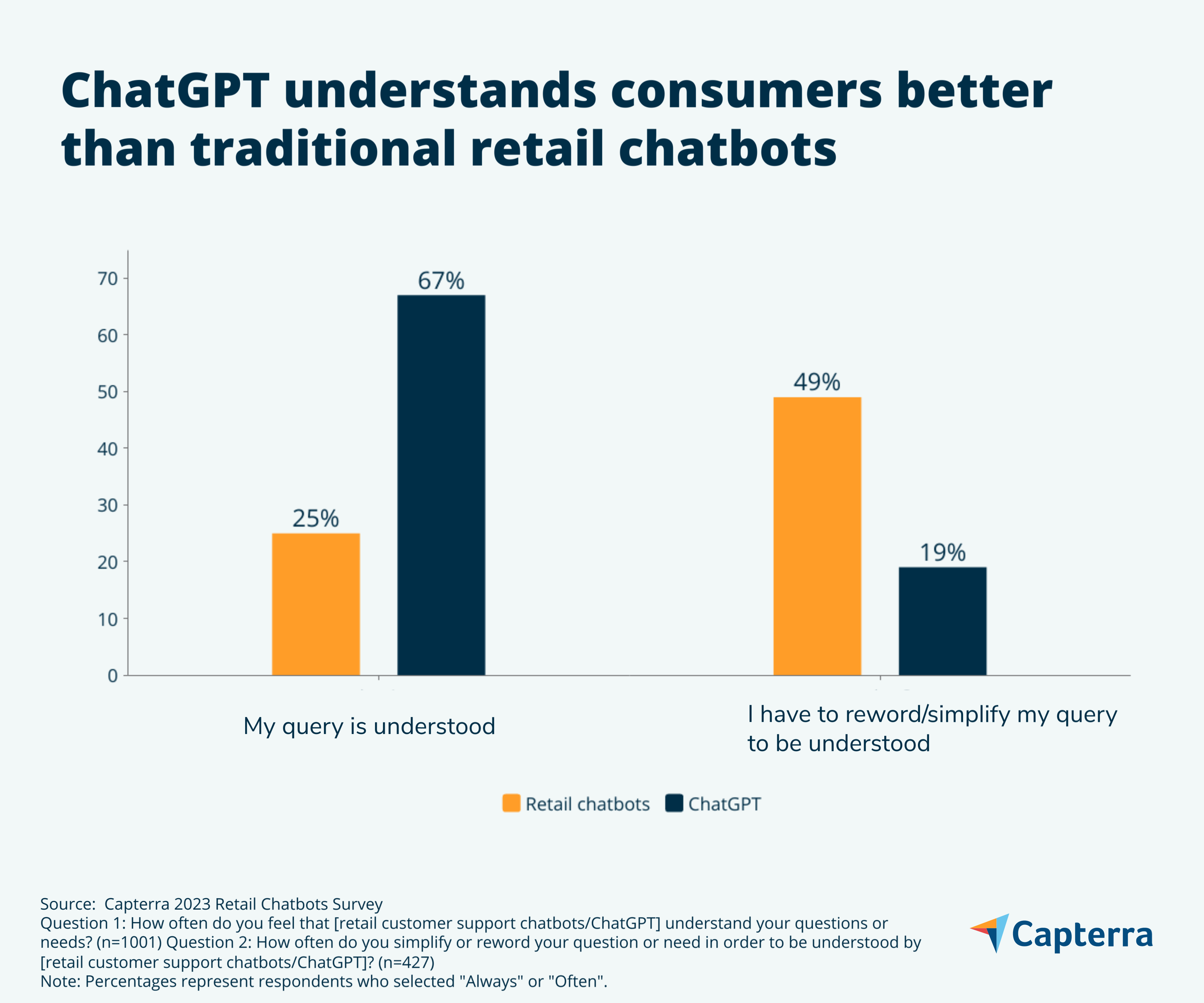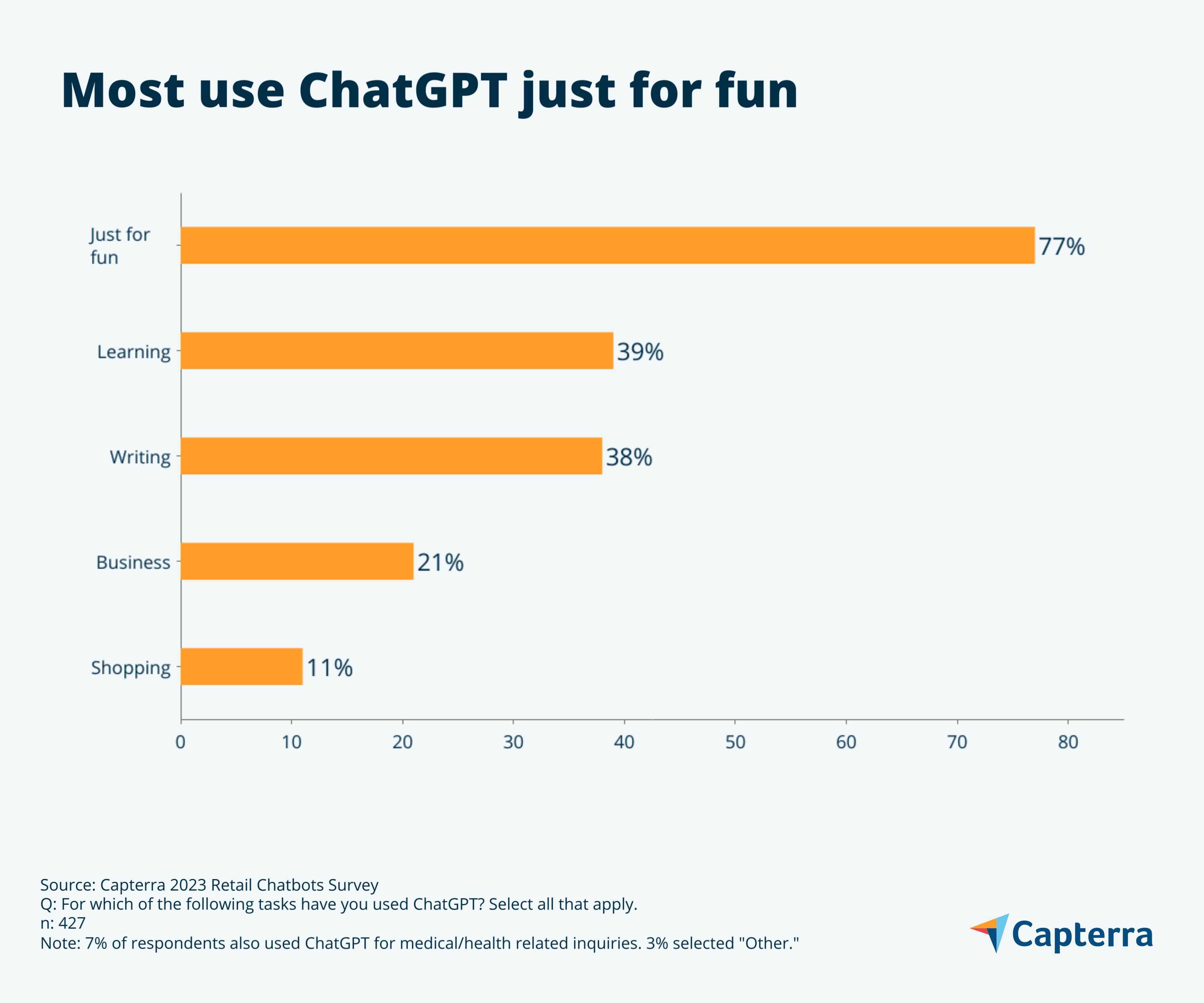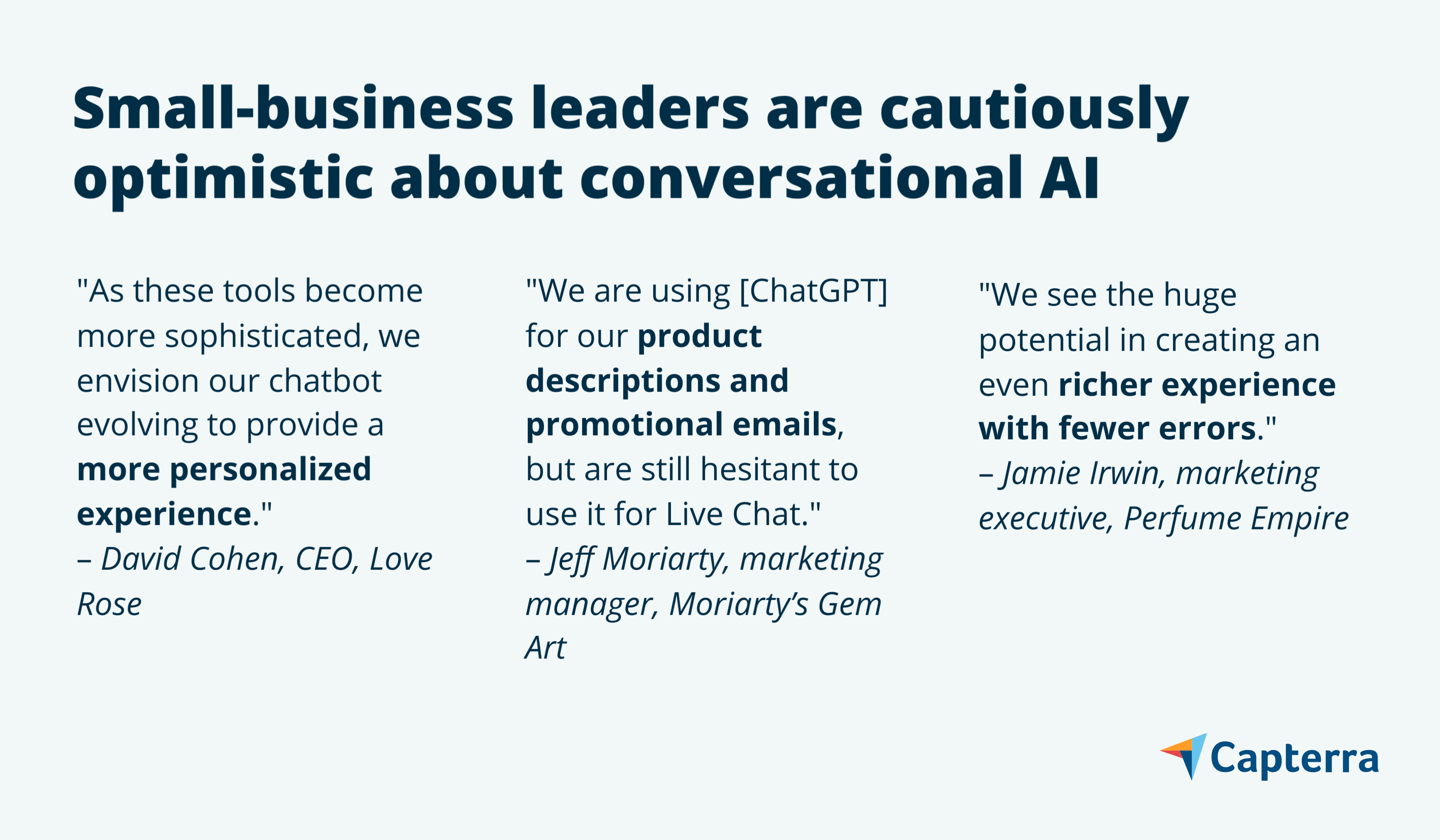AI brings efficiency and understanding to chatbot experiences.
The average customer support chatbot in the retail industry has a ways to go before it can keep pace with human customer service agents, let alone replace them. Without the ability to handle nuance, traditional chatbots tend to frustrate customers and business owners alike.
Conversational artificial intelligence tools such as Open AI’s ChatGPT seek to bridge that gap. These next-generation chatbots are built to support customer needs as well or better than humans and deliver an unprecedented level of personalization to online shopping.
But until that technology is ready, small-business leaders need guidelines so their support chatbots can engage with customers effectively.
We surveyed over 1,000 U.S. consumers and interviewed retailers to understand their pain points with traditional chatbots and how conversational AI could influence the future of online customer support. Using those insights, we offer strategies on how your small retail businesses can get the most out of traditional retail chatbots while you wait for the new generation of conversational AI tools to hit the market.
/ Key findings
Traditional chatbots fail to meet customer expectations: 53% of consumers who have used retail customer support chatbots rate their overall experience as “fair” or “poor.”
Traditional chatbots lack sales prowess: Only 17% of retail chatbot users have used a bot to search for products, and just 7% have used it to receive product recommendations.
ChatGPT improves upon common issues with retail chatbots: 67% of ChatGPT users feel understood by the bot often or always, versus only 25% of retail chatbot users.
ChatGPT wows users, but is underutilized for online shopping: 56% of respondents who have used ChatGPT for any purpose say they’re likely to shop from a brand that offers a similar tool. However, only 11% have used the bot specifically for shopping purposes.
Traditional retail chatbot technology misses the mark
According to Capterra’s 2023 Retail Chatbots Survey*, there’s a big problem with today’s retail customer support chatbots: They don’t work for the average user. Chatbot users rate their experiences as fair to poor, and they feel understood by bots only occasionally—and that’s after simplifying their original queries.

Traditional chatbots fail to solve most issues by themselves, and users need to connect with a human agent to get help with complicated questions. Customers mostly use them for straightforward, routine tasks, such as asking simple questions about products and services, tracking orders, and processing returns.
Customers seldom use bots for more nuanced sales purposes, like receiving personalized product recommendations. In fact, only 9% of chatbot users have ever purchased a product because a retailer’s chatbot suggested it.
It’s not just customers that struggle with chatbots’ limited effectiveness. While small-business leaders acknowledge that chatbots can save their employees time answering common questions and resolving routine issues, they encounter a host of issues, including a lack of understanding and personalization, arduous upkeep, and negative customer feedback.
According to David Cohen[1], CEO of Love Rose, chatbots are effective when used to handle basic inquiries, but less so when asked complex questions. “The chatbot sometimes struggles with understanding complex or nuanced questions and may not always provide the level of personalization that our customers expect,” says Cohen.
This inadequacy can elicit backlash from customers. Jeff Moriarty[2] of Moriarty’s Gem Art says that after testing out a chatbot on his website and receiving many dissatisfied comments, his company decided to remove the bot.
But it’s not just that they tend to be ineffective—traditional chatbots also require continual maintenance. “The process currently takes up quite a lot of time, which could be put towards other tasks,” says Jamie Irwin[3], marketing executive for Perfume Empire.
These issues make the prospect of AI-driven chatbots like ChatGPT all the more exciting. With natural language processing, better handling of complexity and nuance, and a greater capacity to craft personalized responses, conversational AI has the potential to improve upon chatbot experiences by simulating the personalization and creativity provided by human agents.
Traditional retail chatbots and conversational AI: What’s the difference?
Traditional retail chatbots are rule-based bots. Rather than holistically interpreting a user’s unique query, rule-based bots either search for keywords within a user’s query, or they offer a clickable menu of sample queries to choose from. They can only respond according to pre-written scripts—they can’t make up answers on their own.
Conversational artificial intelligence (AI) tools use natural language processing and large libraries of data and information to create their own responses to a user’s unique query in real time. These tools can understand and chat with people in a remarkably “human” manner, and can handle queries that lie beyond the scope or comprehension of traditional bots.
ChatGPT is an underused resource for personalized online shopping
ChatGPT, OpenAI’s artificial intelligence chatbot launched in November of 2022 and quickly went viral. Retail news articles demonstrated the bot’s ability to handle a timely creative task— curating holiday gift ideas for difficult-to-shop-for relatives:

With a small amount of background information, ChatGPT can generate personalized product recommendations[4]
ChatGPT’s talent for personal shopping attracted attention from big names in retail such as Shopify and Instacart—companies that have since partnered with OpenAI to develop new chat tools that can process open-ended queries and return personalized recommendations[5].
We asked survey respondents if they have ever used ChatGPT, and how. In terms of effectiveness and intuition, ChatGPT blew existing retail chatbots out of the water:
Among the 43% of respondents who have used ChatGPT at least once, two-thirds say the bot “always” or “often” understands their queries.
ChatGPT users achieve this understanding with significantly less dumbing-down of their questions: Only 19% of the ChatGPT users say they “always” or “often” simplify their queries to be understood by the tool.

Furthermore, most ChatGPT users feel as though ChatGPT is truly speaking to them: 66% say the bot provides recommendations that feel personalized. Over half of our survey’s ChatGPT users say they would be more likely to shop from a retailer that offers a chatbot with ChatGPT’s capabilities.
Despite all this enthusiasm, just 11% of our survey’s ChatGPT users have ever used the AI for shopping purposes, such as asking the bot for product recommendations. Respondents’ highest-reported use case for ChatGPT—by a wide margin—is “just for fun."

If ChatGPT is so much better than existing retail chatbots at comprehension and personalization, why aren’t consumers using the AI as their own personal shopper?
One possibility is that consumers don’t want product recommendations from a bot. Perhaps after years of watching advertising bias skew Google results, they’re leery of algorithm-driven suggestions. Maybe they think it’s creepy to let a robot influence their purchases. They may simply prefer to consult fellow humans on matters of taste and value.
More likely, it’s an awareness problem—consumers may not know they can use ChatGPT for personal shopping because traditional chatbots don’t typically offer that service.
Whatever the reason, it likely won’t remain the case for long. As conversational AI developers continue to roll out tools and collaborations with large retailers, humanlike chatbots could soon become a go-to tool for personalized online shopping.
Small retailers are looking forward to a future in which AI-powered bots can truly support their customer service staff and offer a more satisfying and personalized experience to their customers. Some are already using ChatGPT in other areas of their business, such as creating marketing copy or writing emails.

Rule-based chatbots can be effective with some basic guidelines
Rule-based chatbots can still be an effective tool in a small business’s customer support arsenal while you wait for greater accessibility to conversational AI tools. Here’s how your small business can make the most of traditional chatbot technology and provide great chatbot experiences to your customers.
Make sure your chatbot can easily and conveniently connect users to human customer support agents. If not, your customers will have to find other ways to talk to you, and they may be frustrated.
Prioritize and perfect frequently-used functions, such as order tracking and returns. Determine if there are other top uses of your chatbot, and make sure your bot executes those tasks consistently.
Give your bot a humanlike, upbeat persona. 54% of chatbot users prefer bots with human-like avatars, and 87% prefer them to have a positive attitude. Avoid the uncanny valley effect by notifying users that they’re communicating with a bot, not a person.
Don’t rely solely on a chatbot to handle customer support. A bot should enhance the work of human agents, not replace them.
Reward chatbot users by offering deals and loyalty program enrollment. Chatbots can be a great tool for upselling and retention. They’re also a great way to collect valuable first-party customer data.
To find a chatbot that works for your business, browse Capterra’s list of chatbot software.
Curious about how technology can help your business in other areas? Capterra’s 2023 State of Retail Software Adoption Report shows you how other small retailers are spending on software and applications this year, so you can make an informed decision on your technology investments.
